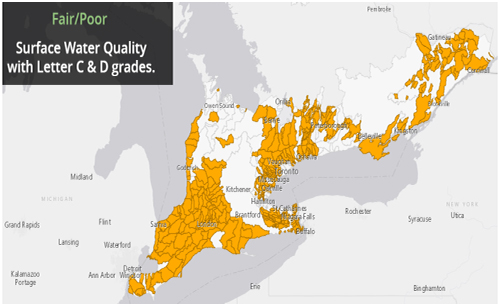- Fecal coliforms ( coli) : Fewer than 100 bacteria per 100 mL water
- Total coliforms: Fewer than 1,000 bacteria per 100 mL water
Source: Canadian Council of Ministers of the Environment November 2008
High generic E. coli counts can occur in any water supply including streams, canals, ponds and lakes. This bacteria has been observed to survive for days to almost a year in soil, manure and water habitats. Rain events can cause significant spikes in E. coli levels. High levels of E. coli in irrigation water are a concern as they indicate fecal contamination, and may be a sign that pathogens are present. Examples of pathogens include Salmonella spp., the Shiga toxin-producing E. coli (STEC) such as E. coli 0157:H7, Campylobacter and parasites such as Cryptosporidium parvum.
Conservation Authorities have been monitoring water quality and producing watershed report cards since 2012. Many monitoring sites showed average E. coli levels above the recommended guideline. Contact your local Conservation Authority for data in your area.

Food safety programs often include the requirement of assessing the quality of your irrigation water. Taking water samples at your pumping location for microbial testing is a good way to get a better idea of what’s in your water.
Ready-to-eat produce, which is not cooked before eating, poses a higher food safety risk, and requires extra precaution during production. If your irrigation water is variable, or poses higher risk due to the presence of E. coli, mitigation strategies must be considered to reduce the risk.
So what options are available to growers if they have variable or high risk water due to the presence of E. coli?
- Use a form of irrigation where the water will not directly contact the fruit i.e. drip irrigation or micro sprinklers (under tree).
- Choose a different water source which meets the Guideline e.g. a well or municipal supply.
- Treat water to improve its quality and meet the Guideline.
The U.S. Food Safety Modernization Act (FSMA), Produce Safety Rule states that it is possible to reduce food safety risks from poor quality irrigation water by establishing a waiting period between the irrigation and harvest. This waiting period is known as the post-harvest interval, or PHI. In the U.S., growers are provided the guidance that E. coli die off will occur at a rate of 1 log for every 2 days. 1 log is equal to a reduction to 10% of the original value. A 2-day PHI will reduce bacterial load to 10% of its original value. A 4-day PHI will reduce bacterial load to 1% of its original value.
This guidance extends to a maximum reduction of E. coli to 1% of its original value. However, the rate at which die off occurs is not guaranteed. Also, the rate at which other pathogens die off, may or may not be the same as E. coli, for example Cryptosporidium oocysts may also be present in the contaminated water and can survive longer. As a result, it is impossible to predict how long growers must wait after irrigating with contaminated water to ensure the crops are not contaminated.
Studies have shown that E. coli can survive more than 25 days on lettuce. The recent E. coli outbreak in romaine lettuce has been tied to tainted Arizona irrigation canal water. This E. coli outbreak has killed one person, sent 75 people to hospital, and sickened 172 people across 30 states. The outbreak has resulted in a significant economic impact to the romaine lettuce industry with a 45% reduction of sales in May, and prices for whole heads of romaine lettuce down 60%.
Contamination of a food product can have wide-ranging and damaging implications for an entire industry. The best way to ensure food safety is to prevent pathogens from coming into contact with crops.
Additional information on sampling irrigation water for food safety and interpreting the results can be found at: http://www.omafra.gov.on.ca/english/food/foodsafety/foodsafetyprograms.htm
Source : ONfruit